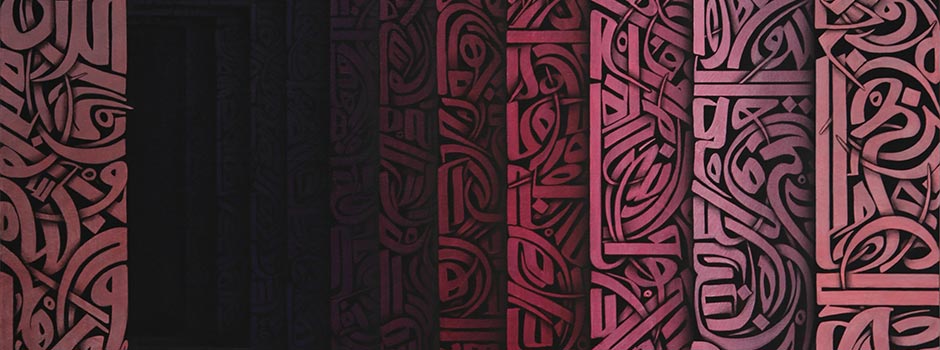
GROUP EXHIBITION AT THE SHOWCASE GALLERY, DUBAI (MAY 9 - JUNE 30, 2018) The Diving Bell & The Butterfly
May 26, 2018 Exhibition

This Ramadan, Showcase Gallery and Mestaria are pleased to present The Diving Bell & The Butterfly, a group exhibition of 11 artists whose work is united by the fact that they use systematic techniques.
Curated by Anna Seaman, the exhibition borrows its title from the novel by French journalist Jean-Dominique Bauby who was paralyzed by a stroke and although only able to move his left eyelid, he wrote his book with the assistance of a translator. He suffered locked-in syndrome, metaphorically referred to as the diving bell, yet still managed a creative output, showing his mind to be free as a butterfly.
For the occasion of Ramadan, where everyday life becomes more structured around fasting hours and the sun’s natural cycle, the exhibition takes on new relevance. The inherent spirituality in the majority of the works is also especially poignant during the Holy Month.
Anna Seaman, the curator of the exhibition, says: "The artists in this show have disparate practices which reflect, in their own varying ways on the dichotomies of life. When making the selection, I wasn’t looking for a single aesthetic, rather a way of working that acknowledges the act of creative freedom whilst staying within constraints. Viewed together, the artwork offers audiences the chance to ponder upon the systems that exist in daily life as well as enjoying stunning pieces of craftsmanship from regional practitioners."
The group exhibition shows works by 11 artists: Wissam Shawkat, Sasan Nasernia, Ebtisam Abdulaziz, Afshan Daneshvar, Mariam Abbas, Ahmed Al Faresi, Julia Ibbini, Katie Venner-Woodbridge, Amal Al Gurg, Nathaniel Alapide and Jessica Watson-Thorp.
Wissam Shawkat is an Iraqi artist based in Dubai who dedicated his life to learning the strict rules of Arabic calligraphy only to later subvert them. He has adapted his form and experimented with medium and presentation to create works that can still be defined as calligraphic but are minimalist in aesthetic and conceptually contemporary.
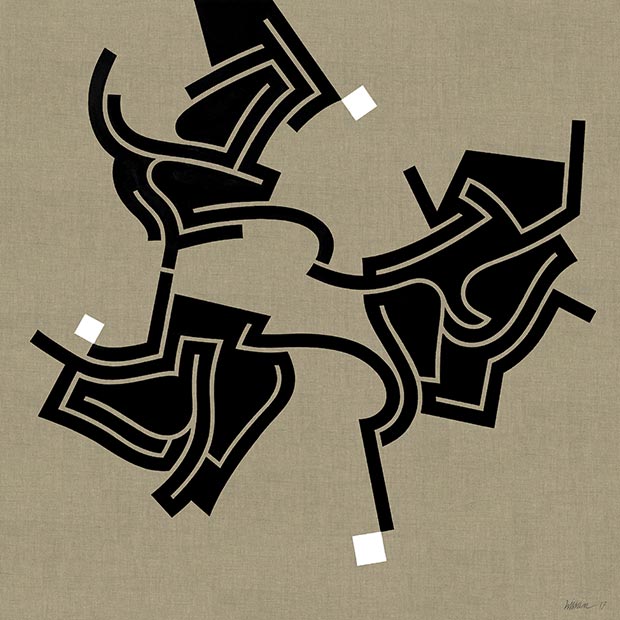 Wissam Shawkat, Gathering 3, Acrylic on Linen Canvas, 100x100 cm / © Wissam Shawkat 2018 / Courtesy of Mestaria
Wissam Shawkat, Gathering 3, Acrylic on Linen Canvas, 100x100 cm / © Wissam Shawkat 2018 / Courtesy of Mestaria
Afshan Daneshvar is a Dubai-based, Iranian artist. Mentored in Islamic calligraphy by her father, she has used it in her practice since 2004. Her meditative work is based on repetition. Since 2015, she has been exploring paper as a medium. The work she is exhibitng is from her 'Boats' series. Though seemingly identical, each individual origami boat is hand-made and therefore unique. Amassed together and in this case, unfolded from their original form, the boats represent humanity floating in the sea of life.
Sasan Nasernia is an Iranian artist based in Vancouver. He uses letter forms as his building blocks and draws inspiration from his Persian heritage to delve into the means humanity uses to communicate. He is not always concerned with the rules and meaning of the written word, instead he couches his practice in a fascination with writing as a coded system. In this large canvas, he has created a 3D portal to suggest another dimension away beyond the plane upon which it is hung.
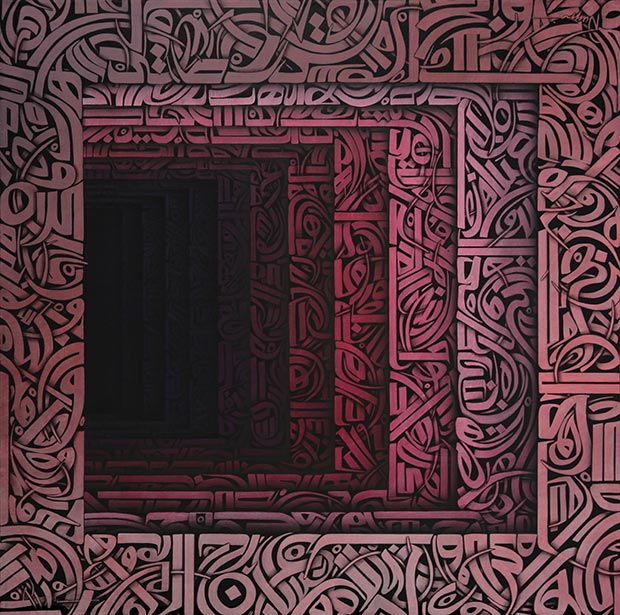 Sasan Nasernia, Otherside, Oil on Canvas / © Sasan Nasernia 2018 / Courtesy of Mestaria
Sasan Nasernia, Otherside, Oil on Canvas / © Sasan Nasernia 2018 / Courtesy of Mestaria
As well as being one of the UAE’s leading conceptual artists, Abdulaziz is also a scientist. She graduated with a double bachelor’s degree in mathematics and science from Al Ain University in 1999. Her work is based on systems to communicate information not otherwise legible. 'Words In Art' is a series of statements that the artist has created a coded language to express. The final pieces are viewed in pairs: a geometric drawing coupled with a graph that explains the system. "Manipulating numbers and mathematical systems is simply a cry of revolt against the shackles of oppressive regimes," she says.
Emirati illustrative artist Mariam Abbas restricts her practice in technique and size. She creates miniature drawings sometimes no bigger than a coin and uses the pointillism technique to shed light on old Arabic urban spaces. The series of miniature mosques are pencil drawings and the street scenes are made from tiny dots of ink, which take over 100 hours to complete to such a level of precise detail.
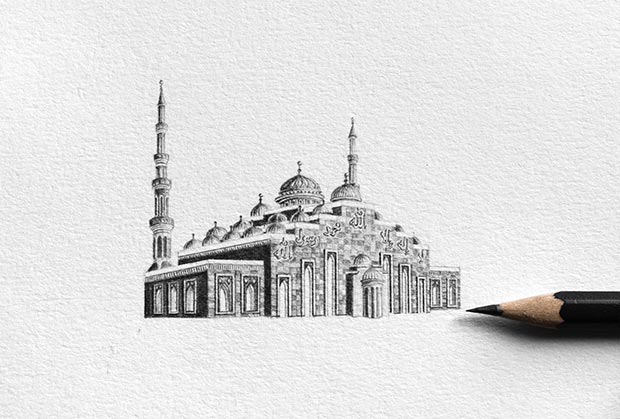 Mariam Abbas, Miniature Masjid D, Paper / © Mariam Abbas 2018 / Courtesy of Mestaria
Mariam Abbas, Miniature Masjid D, Paper / © Mariam Abbas 2018 / Courtesy of Mestaria
Ahmed Al Faresi is a self- taught Emirati artist who works through the medium of mixed media. He lives and works in Al Ain where he is an assistant professor at the Faculty of Information Technology (FIT) in United Arab Emirates University. He is interested in science, technology and information coding and as such, has focused in the two exhibited pieces on the repeated use of the infinity symbol, which represents the universality of being.
With Jordanian-British heritage, Julia Ibbini has lived her entire life in the UAE and her work reflects both her layered and complex multicultural experience as well as the geometry and symbolism inherent with the Middle East region. Her work stems from a fascination with complex pattern and is made of many layers of laser cut archival paper and mylar, which are then emphasised with bold inks and paint.
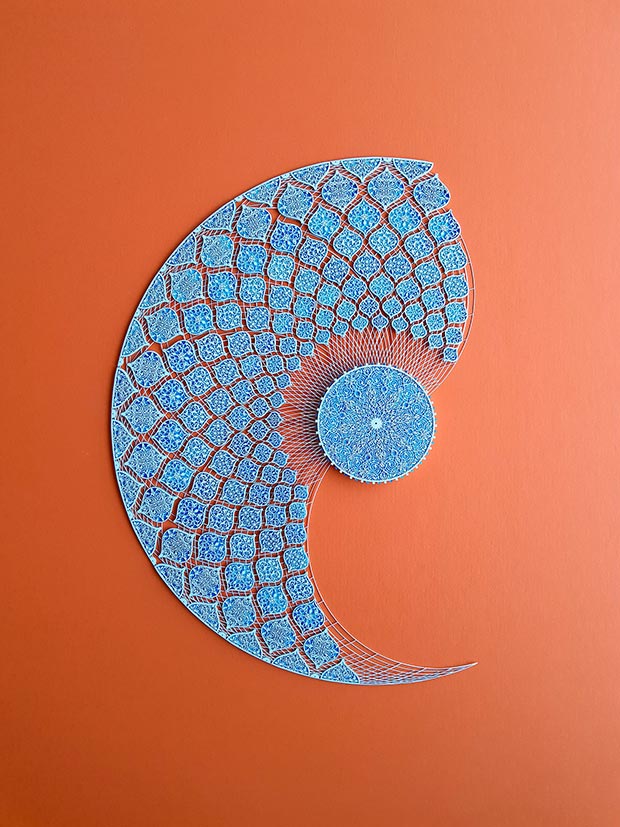 Julia Ibbini, Study No.1 for the Sublime Line, 85x100 cm, Cut paper layers over metallic ink on Mylar / © Julia Ibbini 2018 / Courtesy of Mestaria
Julia Ibbini, Study No.1 for the Sublime Line, 85x100 cm, Cut paper layers over metallic ink on Mylar / © Julia Ibbini 2018 / Courtesy of Mestaria
British artist Katie Venner-Woodbridge’s inspiration comes from the rhythms of everyday life. She draws lines and geometric patterns based on architectural structures and then fractures them to create her abstract works. The smaller paper works are from a project called '100 Days', where she used freehand drawings and watercolour to create a daily artwork over this period. The larger canvas, Home, is based on the wider city of Dubai – where she has lived since 2011.
 Katie Venner-Woodbride, Series of Ink and Acrylic on 300 gm Watercolour Paper, 28x19 cm each / © Katie Venner-Woodbride 2018 / Courtesy of Mestaria
Katie Venner-Woodbride, Series of Ink and Acrylic on 300 gm Watercolour Paper, 28x19 cm each / © Katie Venner-Woodbride 2018 / Courtesy of Mestaria
An Emirati graphic-inspired artist, Amal Al Gurg enjoys both design and calligraphy. In the exhibited works she has deconstructed Arabic letters to become illustrative tools. The largest piece, Amalgamate uses two specific letters (thal and alef) to represent the male and female. The letters do not touch, so the work acknowledges societal restrictions of gender segregation yet the finished piece also celebrates unity.
A multidisciplinary and self-taught Filipino artist, Nathaniel Alapide’s process is one of ritual. He uses magazines as his canvas and treats them by burning, cutting, ripping and drilling screws into them until he is satisfied with the result. For this series, the butterflies represent the fragility of life. Alapide is interested in the laws of opposites that surround us such as order and chaos; day and night and black and white – hence the monochromatic nature of his work.
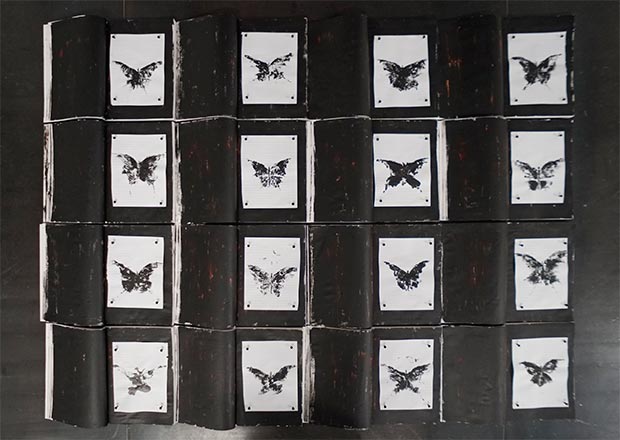 Nathanial Alapdie, The Diving Bell & The Butterfly / © Nathanial Alapdie 2018 / Courtesy of Mestaria
Nathanial Alapdie, The Diving Bell & The Butterfly / © Nathanial Alapdie 2018 / Courtesy of Mestaria
Jessica Watson-Thorp is an Australian artist who has been living in the Middle East since 2003. As a painter she has a long-standing interest in the aesthetic details of the region’s architecture and in particular the patterns of the mashrabiya latticework. These monoprints from her latest series are based on the daily sequence of Islamic prayer; the number of units, the timings and the sun’s position.
The exhibition opened at the Showcase Gallery on May 9 and will run until June 30, 2018. The gallery is located at the Alserkal Avenue in Dubai.
Comments
Add a comment